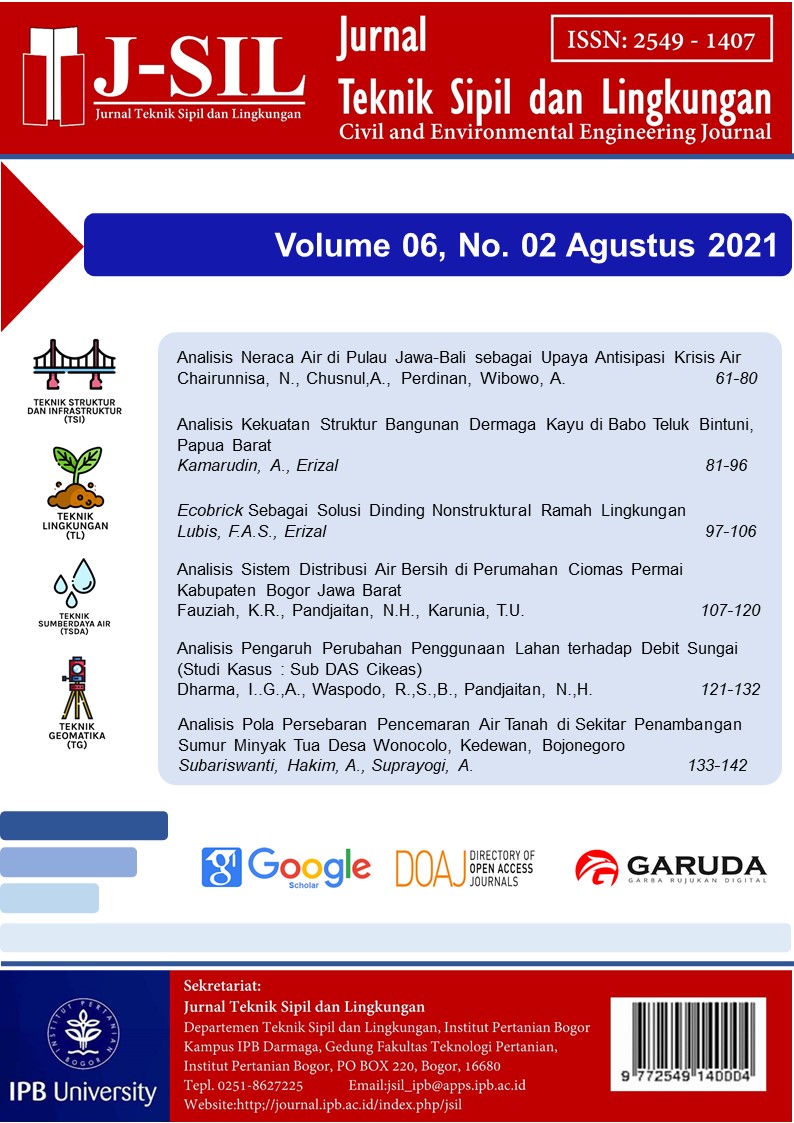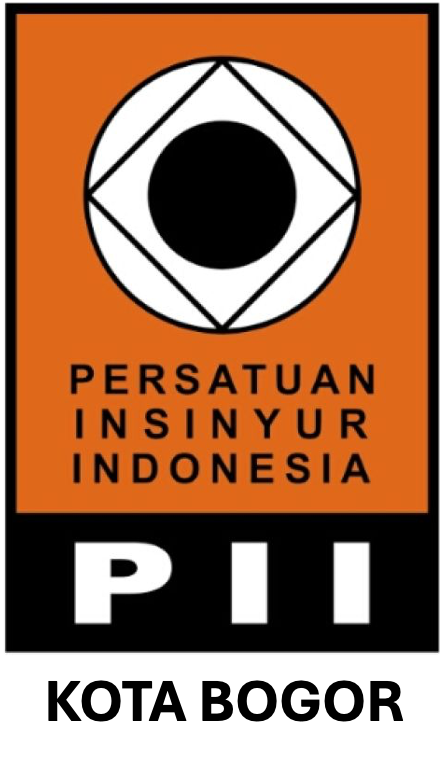Ecobrick Sebagai Solusi Dinding Nonstruktural Ramah Lingkungan
Ecobrick As an Eco-friendly Nonstructural Wall Solution
Abstract
Population growth increased in the need for dwelling which impacted to high demand for bricks. However, bricks have a negative impact on the environment due to the materials and the production prosses. Population growth also effected an increase amount of plastic waste that has a risk to the health and environment. This research aimed to analyze the compressive and flexural strength of brick and ecobrick (PET bottle filled with plastic waste) wall, to know degree of difference in strength between both wall, and to compare the cost of making the wall. This research was started from preparation, manufactured, cured, and tested the specimens. The cost analysis refers to the Bogor district in 2019. The result was obtained compressive strength of brick is higher than ecobrick, which is brick 2,38 MPa and ecobrick 1,31 MPa. Flexural strength of ecobrick is higher than brick, which is ecobrick 1,23 MPa and brick 1,18 MPa. T-test show that compressive strength both wall is significantly different, while the flexural strength both wall is not significantly different. The cost of making ecobrick walls is 20% cheaper than brick walls.
Downloads
References
Aminudin, Nurwati. 2019. Pemanfaatan sampah plastik menjadi kerajinan tangan guna meningkatkan kreatifitas warga sekitar Institut Teknologi dan Bisnis Ahmad Dahlan (ITB-AD) Jakarta. Jurnal Pengabdian Kepada Masyarakat. 2(1): 66-79.
Asih HM, Fitriani S. 2018. Penyusunan standard operating procedure (SOP) produksi produk inovasi ecobrick. Jurnal Ilmiah Teknik dan Industri. 17(2): 144-150.
[BSN] Badan Standardisasi Nasional. 1996a. Metode pengujian kuat tekan dinding pasangan bata merah di laboratorium. SNI 03-4164-1996. Jakarta (ID): BSN.
[BSN] Badan Standardisasi Nasional. 1996b. Metode pengujian kuat lentur dinding pasangan bata di laboratorium. SNI 03-4165-1996. Jakarta (ID): BSN.
[BSN] Badan Standardisasi Nasional. 2000. Bata merah pejal untuk pasangan dinding. SNI 15-2094-2000. Jakarta (ID): BSN.
[BSN] Badan Standardisasi Nasional. 2008a. Tata cara perhitungan harga satuan pekerjaan plesteran untuk konsruksi gedung dan perumahan. SNI 2837- 2008. Jakarta (ID): BSN.
[BSN] Badan Standardisasi Nasional. 2008b. Tata cara perhitungan harga satuan pekerjaan dinding untuk konsruksi gedung dan perumahan. SNI 6897-2008. Jakarta (ID): BSN.
Hastutiningrum S. 2013. Proses pembuatan batu bata berpori dari tanah liat dan kaca. Jurnal Teknologi Technoscienta. 2(5): 200-206.
Hendra Y, Muchoyar I. 2014. Studi eksperimen kuat lekat mortar biasa pada pasangan beton ringan aerasi. INERSIA. 10(2): 144-153.
Hendriyani I, Marini A, Putri NI. 2018. Analisis SWOT Pemilihan Material Dinding Bata Merah dan Bata Ringan di Penajam Paser Utara. Jurnal Teknik Sipil. 2(1): 22-32.
[Kementrian PUPR] Kementrian Pekerjaan Umum dan Perumahan Rakyat. 2016. Materi Praktis Pekerja Konstruksi Pekerja Pemasangan Bata. Jakarta (ID): Kementrian PUPR.
Copyright (c) 2021 Jurnal Teknik Sipil dan Lingkungan

This work is licensed under a Creative Commons Attribution-NonCommercial-NoDerivatives 4.0 International License.
Authors who publish with Jurnal Teknik Sipil dan Lingkungan, JSIL agree to the following terms:
a. Authors retain copyright and grant the journal right of first publication with the work simultaneously licensed under a Creative Commons Attribution License that allows others to share the work with an acknowledgment of the work's authorship and initial publication in this journal.
b. Authors are able to enter into separate, additional contractual arrangements for the non-exclusive distribution of the journal's published version of the work (e.g., post it to an institutional repository or publish it in a book), with an acknowledgment of its initial publication in this journal.
c. Authors are permitted and encouraged to post their work online (e.g., in institutional repositories or on their website) prior to and during the submission process, as it can lead to productive exchanges, as well as earlier and greater citation of published work (See The Effect of Open Access).











